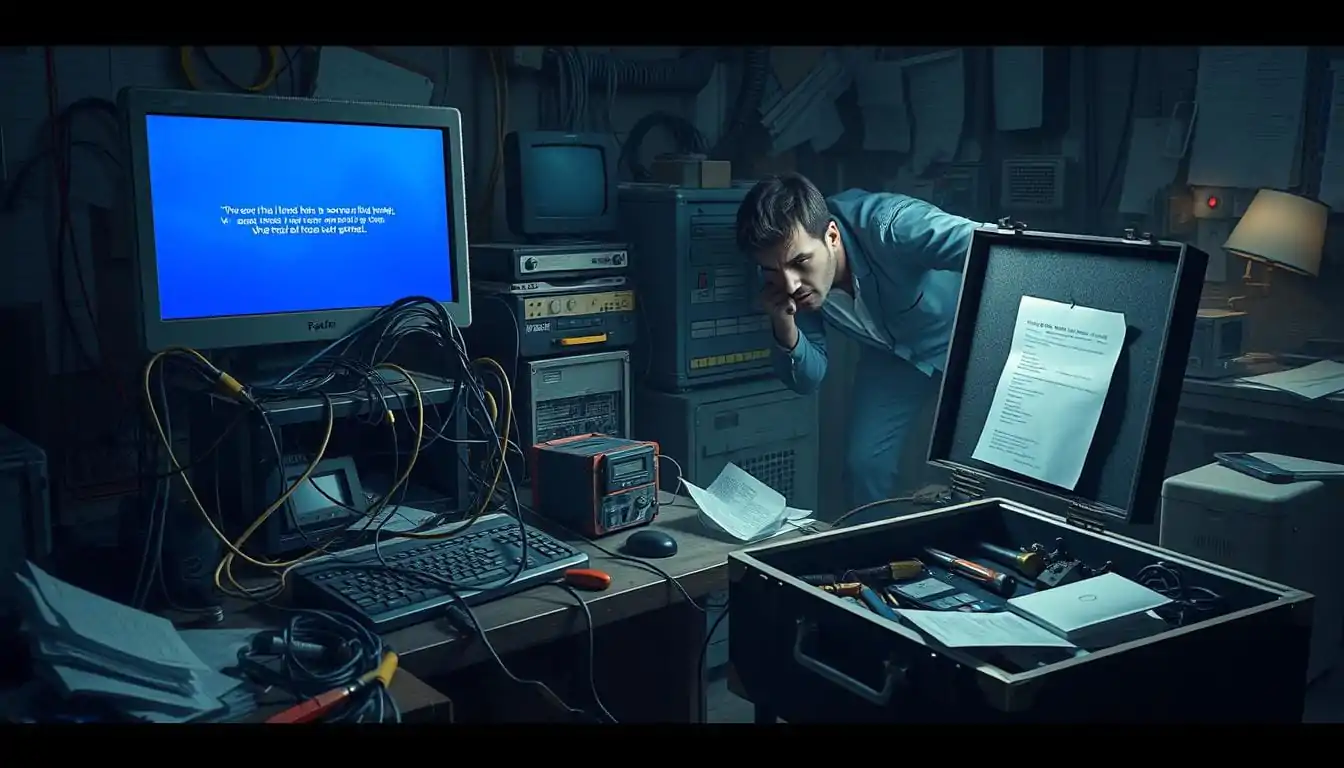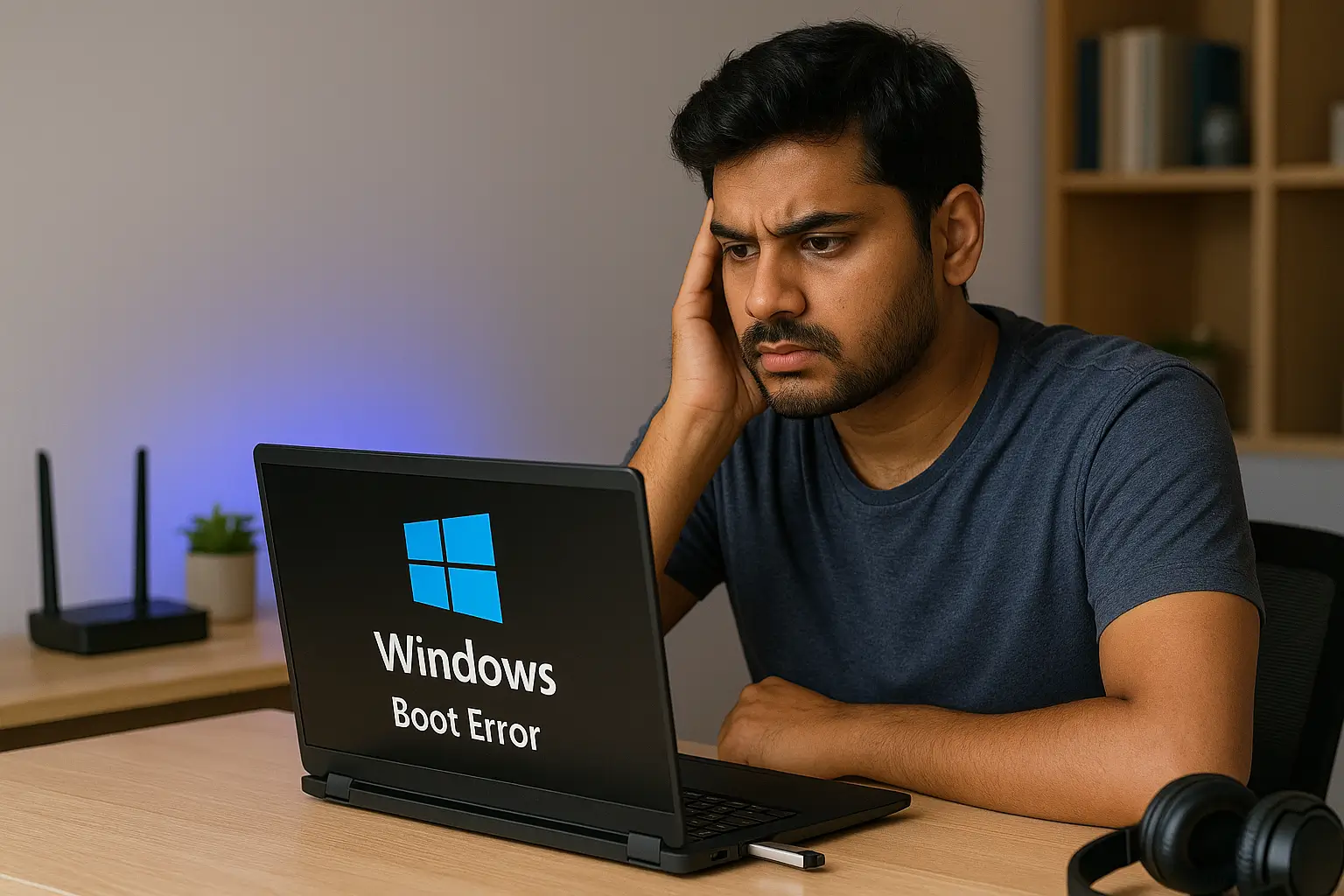Are you tired of dealing with unexpected Windows crashes and blue screen errors? You’re not alone. Many Windows users in India face these issues, which can really mess up your day. But, with the right steps, you can fix these problems and get your system running smoothly again.
This guide will help you tackle common Windows crashes. You’ll learn how to fix blue screen errors and get your PC back in shape. It doesn’t matter if it’s system freezes, software problems, or hardware issues. This article will give you the tools to beat Windows crashes and keep your computer stable.
Table of Contents:
Key Takeaways
- Understand the common causes of Windows crashes, including blue screen errors and system freezes.
- Identify the error code associated with blue screen errors to pinpoint the underlying issue.
- Implement basic troubleshooting steps to address Windows crashes, such as checking for driver updates and performing a memory test.
- Resolve hardware-related issues and software conflicts that can contribute to Windows crashes.
- Utilize advanced troubleshooting techniques, including system restore and recovery options, to regain a stable computing environment.
Understanding Windows Crashes
If you use Windows, you might have seen those scary windowscrashes and bluescreenerrors. They can really mess up your work and make you upset. Knowing what causes these crashes is the first step to fixing them.
Common Causes of Blue Screen Errors
Blue screen errors, or “blue screen of death” (BSOD), happen for many reasons. These include bad or damaged drivers, faulty hardware, software problems, and corrupted system files. Each error has a unique code that can tell you what’s wrong.
Identifying the Error Code
When a blue screen error pops up, it shows an error code like “0x0000000A” or “0x0000003B.” These codes help you find out what’s causing the crash. By looking up the code, you can learn more about the problem and how to fix it.
Knowing why windowscrashes and bluescreenerrors happen and how to spot the error codes is key. This knowledge lets you fix these issues quickly. With it, you can make your system stable again and avoid these sudden problems.
“Troubleshooting Windows crashes is a crucial skill in the digital age, as these unexpected system failures can have a significant impact on productivity and overall user experience.”
Basic Troubleshooting Steps
When you face a windowscrashes, it’s key to troubleshoot it step by step. By following a few basic steps, you can often fix common Windows problems. This will help get your system running smoothly again. Let’s look at some important troubleshooting steps you can take.
Restart Your Computer
A simple restart can solve many windowscrashes issues. Just turn off your computer, wait a bit, and then turn it back on. This can fix any temporary problems that caused the crash.
Check for Hardware Conflicts
Hardware problems often cause windowscrashes. Make sure your hardware, like the motherboard and RAM, is working right. Use Windows Troubleshooter or other tools to find any hardware issues.
Investigate Software Conflicts
Software conflicts can also lead to windowscrashes. Look for new apps or updates that might be causing trouble. Try uninstalling or disabling any software that seems to be the problem.
Run Basic Diagnostics
Windows has tools to help find and fix windowscrashes. Run a system scan with Windows Defender Offline or System File Checker. These tools check for any damaged or missing system files.
By taking these basic steps, you can often find and fix the cause of your windowscrashes. If the problem doesn’t go away or you’re not sure what to do, it’s wise to get help from a professional.
Windowscrashes: Resolving Hardware Issues
Hardware problems often cause Windows crashes. It’s key to find and fix these issues for a smooth computer experience. We’ll look at two important steps: checking for driver updates and doing a memory test.
Checking for Driver Updates
Old or wrong drivers can cause system problems, like crashes. It’s smart to update drivers regularly. You can find updates on your hardware’s website or use Windows tools like Device Manager.
Performing a Memory Test
Bad memory can lead to crashes too. To check for memory problems, use tools like Windows Memory Diagnostic or Memtest86. These tests can find and fix any memory issues.
| Step | Description |
|---|---|
| 1. Check for Driver Updates | Visit manufacturer websites or use Windows tools to identify and install the latest drivers for your hardware components. |
| 2. Perform a Memory Test | Utilize Windows Memory Diagnostic or Memtest86 to thoroughly test your system’s RAM for any errors or instabilities. |
By taking these steps, you can solve hardware problems that cause crashes. This will make your Windows computer more stable and efficient.
Dealing with Software Conflicts
When troubleshooting windowscrashes, software conflicts are often the main cause. Uninstalling problematic programs is key to fixing these problems and making your Windows system stable again.
Uninstalling Problematic Programs
If you think a certain software is causing windowscrashes, start by finding and removing it. Here’s how to do it:
- Open the Start menu and search for “Control Panel”.
- In the Control Panel, go to “Programs” and then “Uninstall a program”.
- Look through the list of installed programs for any that might be causing trouble.
- Choose the problematic program and click “Uninstall”.
- Follow the instructions on the screen to finish uninstalling.
Remember, uninstalling a program might not fix all windowscrashes. Sometimes, the program leaves behind files or registry entries that still cause problems. If the issue doesn’t go away, you might need to try more advanced fixes.
| Symptom | Potential Cause | Recommended Action |
|---|---|---|
| Frequent windowscrashes | Software conflicts | Uninstall problematic programs |
| System instability | Incompatible software | Identify and remove conflicting programs |
| Unexplained errors | Residual program files | Use a registry cleaner or system restore |
“Uninstalling problematic programs is a crucial step in resolving software conflicts and restoring the stability of your Windows system.”
By taking these steps and tackling software issues early, you can lower the chance of windowscrashes and keep your computer running smoothly.
Advanced Troubleshooting Techniques
When basic steps don’t fix your windowscrashes, it’s time for more advanced methods. System Restore is a powerful tool. It lets you go back to a stable state your system was in before.
Using System Restore and Recovery Options
System Restore is a Windows feature that saves snapshots of your system. If you’re stuck with windowscrashes, it can take you back to a good time. This can fix deeper problems and help you control your PC again.
Windows also has other recovery options like Windows Recovery Environment (Windows RE) and Advanced Startup Options. These tools help you find and fix complex windowscrashes.
- Start System Restore by searching for “System Restore” in the Start menu and picking the right option.
- Look through the restore points and pick one from before the crashes started.
- Follow the instructions on screen to finish the System Restore. This might need a reboot.
- If System Restore doesn’t work, try Windows Recovery Environment or Advanced Startup Options for more tools.
Using these advanced methods can solve serious problems and fix your system. Always be careful and back up your important files before making big changes.
“System Restore can be a lifesaver when it comes to resolving complex windowscrashes issues.”
Preventing Future Windows Crashes
Staying proactive is key to avoiding future windowscrashes. By following a few simple steps, you can significantly reduce the risk of system crashes. This ensures a smooth, uninterrupted computing experience.
Maintain Regular System Updates
Microsoft regularly releases updates and patches for the Windows operating system. These updates address security vulnerabilities, improve performance, and fix known issues. Keeping your system up-to-date is crucial to prevent windowscrashes.
Enable automatic updates or check for updates manually. This ensures your system is running the latest version of Windows.
- Enable Windows Update to automatically download and install the latest updates.
- Regularly check the Windows Update settings and install any available updates.
- Reboot your computer after installing updates to ensure the changes take effect.
By staying on top of system updates, you can significantly reduce the likelihood of windowscrashes. This is due to software bugs or security vulnerabilities.
Implement Best Practices for System Maintenance
Regular system maintenance can also help prevent future windowscrashes. Here are some best practices to follow:
- Run a disk defragmentation tool to optimize your hard drive’s performance.
- Use a reliable anti-virus program to protect your system from malware and other threats.
- Periodically clean your system’s registry to remove any unnecessary or corrupt entries.
- Ensure your system has sufficient storage space to avoid performance issues.
By taking these proactive steps, you can help maintain the overall health and stability of your Windows system. This reduces the risk of frustrating windowscrashes.
“Preventive maintenance is the key to a healthy, crash-free Windows system.”
| Maintenance Task | Benefits |
|---|---|
| Disk Defragmentation | Improves file access speed and system performance |
| Anti-virus Protection | Safeguards against malware and security threats |
| Registry Cleaning | Removes unnecessary and corrupt registry entries |
| Sufficient Storage Space | Prevents performance issues and system crashes |
By staying on top of system updates and implementing best practices for maintenance, you can significantly reduce the likelihood of future windowscrashes. This ensures a more reliable and enjoyable computing experience.
Effective Data Backup Strategies
When windowscrashes happen, keeping your data safe is crucial. Good backup plans can protect your files and important info. They help keep your data safe even if your computer fails.
Using an external hard drive is a solid backup method. It keeps your data safe by moving it to a separate device. This way, your files are less likely to get lost in a windowscrash.
Cloud-based backup services like Google Drive or Dropbox are also great. They sync your files online, so you can get to them from anywhere. This method keeps your data safe and lets you access it from different devices.
For the best protection, mix both external hard drives and cloud services. This way, your data is safe in two places. It’s a strong plan against windowscrashes.
“Backup, backup, backup – it’s the mantra for the digital age. Don’t wait until it’s too late to protect your irreplaceable data.”
It’s important to check your backups regularly. Set reminders and test your backups to make sure they work. This way, you can be sure your data is safe, even when windowscrashes happen.
| Backup Method | Advantages | Disadvantages |
|---|---|---|
| External Hard Drive |
|
|
| Cloud-based Backup |
|
|
Seeking Professional Assistance
While you can fix many windowscrashes on your own, sometimes you need a pro. Knowing when to ask for help is key to fixing your system fast and avoiding more problems.
When to Contact Technical Support
Here are times when you should call tech support:
- When windowscrashes keep happening and you can’t fix them
- If your system suddenly starts acting weird or slow
- When you can’t find the problem, even after trying everything
- If you think there might be a hardware or software problem
- When you can’t get your system working right again
Knowing when to stop trying to fix it yourself is important. This way, you can get help and fix your windowscrashes quickly.
Experts in tech support have the skills and tools to solve tough windowscrashes. They can figure out what’s wrong and fix it, making your device work great again.
It’s okay to ask for help when you’ve tried everything yourself. Getting professional help can save you time, stress, and might even prevent more damage to your system.
Conclusion
You now know how to handle Windows crashes. You’ve learned about common causes and how to fix them. You also know how to keep your computer running smoothly.
Keep your system updated and back up your data regularly. If you need help, don’t hesitate to ask a professional. This will keep your Windows running well.
As technology changes, remember what you’ve learned. Stay on top of your computer’s health. Knowledge is key to a better computing experience.
FAQ
What are the common causes of blue screen errors in Windows?
Blue screen errors, also known as the Blue Screen of Death (BSOD), can happen for many reasons. These include hardware failures, driver conflicts, software incompatibilities, and system corruption.
How can I identify the specific error code associated with a Windows crash?
When Windows crashes, you’ll see a blue screen with an error code. Codes like “0x0000000A” or “STOP 0x0000000D” can help you find the problem. This info is key to fixing the issue.
What are the basic steps I should take when troubleshooting a Windows crash?
For Windows crashes, start by restarting your computer. Then, check for any hardware or software conflicts. Run diagnostic tools and make sure your system and drivers are current.
How can I address hardware-related issues that may be causing Windows crashes?
To fix hardware problems, update your drivers and run a memory test. Also, check that your system’s hardware is compatible and working right.
What can I do to resolve software conflicts that are leading to Windows crashes?
To solve software issues, try uninstalling problem programs. Disable startup items you don’t need. Also, scan for malware to find and remove any threats.
What are some advanced troubleshooting techniques I can use to address complex Windows crashes?
For tough crashes, use system restore and recovery to go back to a stable state. Run advanced diagnostic tools to find and fix deeper problems.
How can I prevent future Windows crashes from occurring?
To avoid crashes, keep your system and drivers updated. Regular maintenance and good backups can also help prevent crashes.
When should I seek professional assistance for troubleshooting Windows crashes?
If you’ve tried everything and still can’t fix crashes, it’s time to get help. Look for qualified tech support who can offer specialized help and advice.





